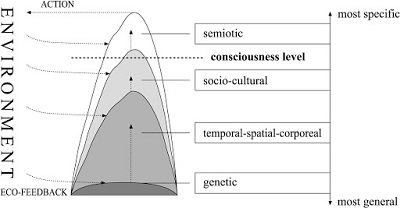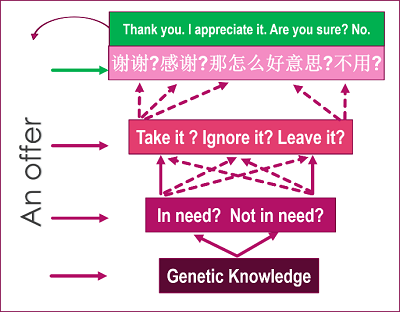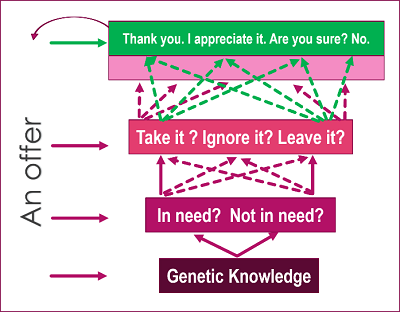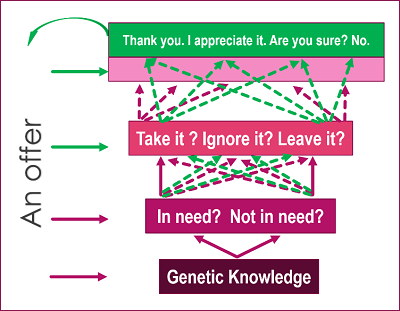 |
Aspired to popularize English so that it is “no longer linked
to a single culture or nation” (McKay, 2002, p. 24), English as an
international language teachers are encouraged to expose learners to
different cultures, avoid privileging any native-speaking English
cultures, and expect students to develop multicultural perspectives
without feeling pressed to adjust their communicative behaviors to any
specific English-speaking cultural group. Such teaching practices, while
making English classrooms more democratic, are susceptible to
unfavorable side effects on the cultivation of the intended alternative
cultural perspectives. From the perspective of complex adaptive systems
(CAS), mere exposure to or discussion about cultural products and
practices is not sufficient for the emergence of target cultural
perspectives in our knowledge system. The study discussed in this
article aims to visualize the registration of alternative cultural
perspectives in a person’s knowledge system and draw implications for
avoiding the unfavorable side effects of teaching English as an
international language.
Complex Adaptive Systems and Their “Internal Models”
A CAS is a network of many “agents” acting in parallel to adapt
to all the other agents’ behaviors (Holland, 2014). Agents may be
neurons, organisms, minds, or any self-sustaining entity capable of
adapting to its environment. Agents are themselves complex adaptive
systems. The environment of each agent is actually an emergent
phenomenon resulting from its interactions with all other agents. This
is why the context of communication is constantly changing (McDermott,
1976; Erickson, 2004). Agents are acting in parallel, so the system
assumes no center of control. This is why one’s goal-oriented action can
bring about side effects and why pure free will may not exist
(Gazzaniga, 2011; Eagleman, 2015). CAS are emergent and self-organizing.
New orders emerge as the agents’ interactions in novel circumstances
give rise to new patterns that push the original system away from
equilibrium (Kauffman, 1993). Newly emerged orders constitute a new
species of agents, whose interactions give rise to further novel
patterns and add other new species to the system. The constantly
emerging diversities constitute the transformation of CAS over time.
Active engagement in the process of transformation is crucial for CAS to
survive and thrive. The emergent nature of CAS determines that
higher-order thinking, such as cultural perspectives, may only emerge
when people act beyond their initial patterns. Therefore, understanding
how CAS learn and adapt will shed light on how cultural perspectives get
registered in the learner’s knowledge system.
CAS learn from experience. According to John Holland, one of
the founding fathers of complexity science, “All complex adaptive
systems … build models that allow them to anticipate the world”
(Waldrop, 1992, p. 177). The building blocks are the behavior patterns
that worked well in previous experiences. Each concrete experience, or
interaction, is registered in the agents as tacit “if [circumstances and
action]/then [outcome]” hypotheses, which accumulate into an “internal
model” (Holland, 1995, p. 57). The structure of the internal model is
thus determined by the agent’s unique internal structure and the
environment’s feedback concerning its action. Each internal model
“informs the agent of previous outcomes of particular actions in
particular circumstances and the likely outcomes of similar actions in
similar circumstances” (Wilson, 2017, para. 15). At a very large scale, a
cultural perspective is an integral internal model to a human society.
Each social interaction is a fraction of the entire model, so it has the
same level of detail as the entire model. If all
details are not oriented toward the target cultural perspective through
consistent feedback, the target cultural perspective may not get
registered in the learner’s knowledge system. This will be illustrated
with visual aids in a later section. The concept of internal model has
been understood in a variety of different terms, such as “script”
(Schank, 1990; Turner, 1991), “schema” (Rumelhart, 1980), and “proto
story” (Becker, 1995). However, I will keep the term “internal model” to
retain its broadest, systemic sense.
Cultural Perspectives as “Internal Models”
An understanding of how internal models emerge and change will
help us understand how cultural perspectives emerge and evolve as one
learns a language. Though internal models are too complex and dynamic to
be modeled, a visual representation of the human knowledge system (HKS)
will help us begin to conceptualize its complexity and interaction with
environment. Figure 1 is a rough representation of an HKS. The
representation has been inspired by Bateson’s (1972; 1979)
ecology-of-mind theory, Maturana and Varela’s (1992) autopoiesis theory, Nikolić’s (2014) practopoiesis theory, Donald’s (1991) hypothesis of
the three-stage evolution of the modern mind, Tomasello’s (2014)
hypothesis of the three-stage development of human thinking, and
Damasio’s (1999) philosophical account of different levels of
consciousness. The four major species of agents represented in Figure 1
include (1) genetic knowledge (which emerged as the genes interacted
with the environment), (2) temporal-spatial-corporeal knowledge (which
emerged as the body interacted with the environment), (3) sociocultural
knowledge (which emerged as the person interacted with the humanized
environment), and (4) semiotic knowledge (which emerged as the person
interacted with the shared symbolic systems). Each species is a fraction
of a different but interdependent larger system and co-evolves with the
larger system. For example, as the individual adjusts his behaviors in
response to other agents’ actions, his adjustment also contributes to
the evolution of language and culture on a larger scale over time.

Figure 1. Representation of human knowledge system.
The Environment in Figure 1 is emergent and specific to
individual agents. It is not separate from the agent. Each agent
interacts directly with its environment. The hierarchical structure
indicates the relative generalizability of the “if/then” hypotheses
registered in each species. The hypotheses in the same species also
display a similar hierarchy in terms of generalizability across the
larger system. For example, the reading of some gestures or facial
expressions are almost universal, whereas most sound patterns and
written symbols are unique to small groups of people. The more general
the hypotheses, the deeper they sink below consciousness and the less
frequently they change, but the more readily the relevant ones are
singled out for the given circumstance. This is why our body movements
and our perception of social contexts are mostly subconscious and
automatic. The upward arrows represent how one species’ emergence and
action are dependent on the existence of the species below it (which
have emerged earlier in learning and now act more automatically).
We can apply the representation of HKS to visualizing the
potential modifications to the internal model of a Chinese L1 learner’s
system, depending on the English L2 teacher’s feedback style. Figures 2,
3, and 4 represent the eventual effects of accuracy-oriented feedback
(Figure 2), fluency-oriented feedback (Figure 3), and context-oriented
feedback (Figure 4). All three representations assume the class is
communicative and the teacher employs elicitation strategies to allow
students to anticipate her action (i.e., an offer). In each figure, the
arrows indicate the alternative hypotheses that may be useful when an
offer is anticipated. The dotted arrows indicate the hypotheses
registered in the sociocultural agents. The purple colors indicate the
patterns emerged from L1 interactions, whereas the green color indicates
the patterns emerge from L2 interactions. Since adaptation is
conservative (Maturana & Varela, 1992), in any given
circumstance, the system will first test the hypothesis that requires
the minimum structural change of the system. If the action brings about
the anticipated outcome, the hypothesis will be considered viable and
used again in similar circumstances.

Figure 2. Accuracy-oriented models.

Figure 3. Fluency-oriented models.

Figure 4. Context-oriented models.
To respond to an offer in L2, the least costly action for the
system is to find an L2 “equivalent” for what one would say in L1, such
as “Thanks” for the Chinese word “谢谢xièxie” in the case of accepting. If
the only condition for positive feedback is accurate production of the
phrase “Thanks”, the modifications to the existing internal models
(Figure 2) will only involve the semiotic agents, namely “if accept an
offer and ‘Thanks’ instead of ‘Xiexie’, then positive feedback.” With
such models students may either appear retarded or be unintelligible in
spontaneous L2 communication due to the lack of “equivalents” between
cultures. To improve the situation, students may repeatedly perform the
speech act till the phrase “Thanks” becomes activated simultaneously
with the action of accepting. The modification (Figure 3) will then
involve the semiotic and the temporal-spatial-corporeal agents, namely
“if accept an offer and accompany the accepting movement with ‘Thanks’,
then positive feedback.” With such models students may become more
fluent in L2, but not more intelligent or likeable to L2 speakers who
are not familiar with their L1 culture because the judgement as to
whether it is appropriate to take the offer is still made from their L1
perspective. Different societies have different criteria for
culturally-appropriate behaviors (Agar, 1994) and verbalize different
aspects of events (Slobin, 1996).
For the student to automatically recognize social contexts from
an L2 perspective in spontaneous communication, modifications to
internal models must involve the sociocultural agents (Figure 4). For
the sociocultural agents to register useful hypotheses, the social
context of the offer (including the relationship between the people
involved and the content of the offer) must be specified and the teacher
must give negative feedback and model expected actions in the given
situation. The social context contains the basic elements of any
interpersonal interaction, so it is often taken for granted until the
action fails to bring about the anticipated outcome. This is why the
teacher’s consistent context-oriented feedback is crucial for the
emergence of alternative internal models in the learner’s system. For
example, since the Chinese counterpart for “Thanks” is only expected
when one accepts the offer, Chinese L1 learners tend to decline offers
by just saying “No”, whose Chinese counterpart “Búyòng” would suffice
for declining offers in Chinese-speaking contexts. Therefore, in L2
roleplaying, if a student tends to decline offers by just saying “No”,
it is necessary to always remind him to also say “Thanks” and have them
redo the act in the expected manner. The teacher may also have the
student enact situations where it is appropriate to decline offers by
just saying “No” without “Thanks”. For example, if on a cold day my
friend makes an offer by saying “Shall I close the door?” I may simply
say “No. I’m fine” to decline it. By contrast, if the offer is “Shall I
close the door for you?” or “Shall I get you a blanket?” then it would
be more appropriate to decline it by saying “No. I’m fine. Thank
you.”
Implications
Because consistent teacher
feedback concerning cultural behavior is key to the registration of
cultural perspectives, the target English culture(s) for any given class
should naturally be the one(s) of which the teacher can be
representative. The construction of alternative sociocultural models
would require the teacher to make explicit the specific context and
react to students’ behaviors in the ways a local of the target community
might act in the given context. Specific contextual information is
crucial for useful alternative sociocultural models to emerge. A basic
goal for cultural learning is to cultivate the awareness that
communication patterns are specific to particular groups, though some
patterns may be more generalizable than others. For this awareness to be
registered in the learner’s system, the teacher’s feedback must
consistently orient the learner’s communicative behaviors toward
specific cultures. With this awareness, learners will be more observant
and tolerant with cultural differences in cross-cultural communication.
Over time, this awareness will evolve into full-fledged alternative
cultural perspectives.
References
Agar, M. (1994). Language shock: Understanding the
culture of conversation. New York, NY: William Morrow and
Company.
Bateson, G. (1972). Steps to an ecology of mind. New York, NY: Ballantine Books.
Bateson, G. (1979). Mind and nature: A necessary unity. New York, NY: E.P. Dutton.
Becker, A. L. (1995). Beyond translation: Essays
toward a modern philology. Ann Arbor, MI: The University of
Michigan Press.
Damasio, A. (1999). The feeling of what happens: Body
and emotion in the making of consciousness. New York, NY:
Harcourt Brace & Company.
Donald, M. (1991). Origins of the modern mind: Three
stages in the evolution of culture and cognition. Cambridge,
MA: Harvard University Press.
Eagleman, D. (2015). The brain with David Eagleman. [DVD]. United States: PBS.
Erickson, F. (2004). Talk and social theory: Ecologies
of speaking and listening in everyday life. Malden, MA:
Polity Press.
Gazzaniga, M. S. (2011). Who’s in charge? Free will
and the science of the brain. New York, NY:
HarperCollins.
Holland, J. H. (1995). Hidden order: How adaptation
builds complexity. New York, NY: Helix Books.
Holland, J. H. (2014). Complexity: A very short
introduction. New York, NY: Oxford University Press.
Kauffman, S. (1993). Origins of order:
Self-organization and selection in evolution. New York, NY:
Oxford University Press.
Maturana, H. R., & Varela, F. J. (1992). The
tree of knowledge: The biological roots of human understanding
(R. Paolucci, Trans.). Boston, MA: Shambhala.
McDermott, R. P. (1976). Kids make sense: An
ethnographic account of the interactional management of success and
failure in one first grade classroom (Unpublished doctoral
dissertation), Stanford University, CA.
McKay, S. L. (2002). Teaching English as an
international language: Rethinking goals and perspectives. New
York, NY: Oxford University Press.
Masny, D., & Waterhouse, M. (2011). Mapping territories
and creating nomadic pathways with multiple literacies theory. Journal of Curriculum Theorizing, 27(3),
287–307.
Nikolić, D. (2014). Practopoieses: Or how life fosters a mind. Journal of Theoretical Biology, 373, 40–61. doi:10.1016/j.jtbi.2015.03.003
Rumelhart, D. E. (1980). Schemata: The building blocks of
cognition. In R. J. Spiro, B. C. Bruce, & W. F. Brewer (Eds.), Theoretical issues in reading comprehension (pp.
33–58). Hillsdale, NJ: Erlbaum.
Schank, R. C. (1990). Tell me a story: A new look at
real and artificial memory. New York, NY: Macmillan.
Slobin, D. (1996). From “thought and language” to “thinking for
speaking.” In J. J. Gumperz & S. C. Levinson (Eds.), Rethinking linguistic relativity (pp. 70–96).
Cambridge, U.K.: Cambridge University Press.
Tomasello, M. (2014). A natural history of human
thinking. Cambridge, MA: Harvard University Press.
Turner, M. (1991). Reading minds: The study of English
in the age of cognitive science. Princeton, NJ: Princeton
University Press.
Waldrop, M. (1992). Complexity: The emerging science
at the edge of order and chaos. New York, NY: Simon and
Schuster.
Wilson, J. (2017). Learning, adaptation, and the complexity of
human and natural interactions in the ocean. Ecology and
Society, 22(2). Retrieved from
https://www.ecologyandsociety.org/vol22/iss2/art43/
Jianfen Wang, currently assistant professor of
Chinese at Berea College, taught EFL in China for seven years before she
received her MA in TESOL. In her PhD research toward a unitary account
of literacy development, she drew broadly from the natural and social
sciences. This allowed her to reflect critically on TESOL practices. |

